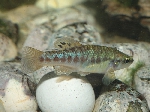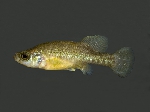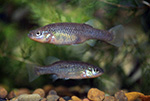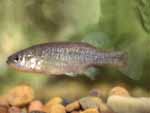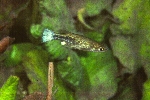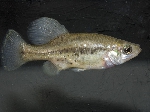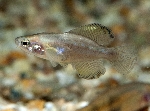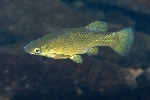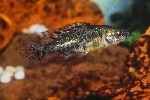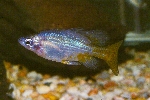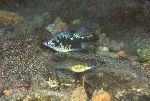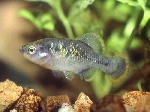
Schutzstatus und Entwicklungstrends von Populationen Mexikanischer Hochlandkärpflinge in der Natur
By Lyons, John
Beiträge zur Biologie und zum Artenschutz der Hoch land kärpflinge, 61-112 2013
" The Mexican fishes or the family Goodeidae have fascinated scientists, naluralists, and aquarists from around the world for nearly a century. But the Goodeids are in trouble in the wild. Habitat destruction, water pollution, and exotic species have caused most species lo become rare, and several, likely now extinct! The distribution and abundance of most species has declined precipitously over the last 10 to 25 years, and the continued survival or many species is precarious. There is an urgent need to conserve the remaining intact natural habitats that support healthy goodeid populations and to establish a worldwide network of goodeid captive breeding and maintenance efforts if the disappearance of this group or fishes is to be prevented.
In this paper I summarize the current (2011) conservation status and population trends of goodeid fishes in the wild in Mexico, updating and expanding upon the status and trends survey from Dominguez-Dominguez et al. (2005a, b). My purpose is to inform aquarium hobbyists of the rapid deterioration of many wild populations and to call attention to the prospects for their continuous existence without immediate intervention. I hope to encourage hobbyists to support on-the-ground conservation efforts in Mexico and 10 participate in the long-term captive rearing and preservation of goodeids as a part of their hobby.
I have based my status and trends designations of the Mexican goodeids on a combination of the recent scientific literature, museum specimens, communication with other goodeid scientists, and my own personal field collections, with emphasis on population data collected within the last 10-15 years. Over the last decade or more, I have sampled many different potential goodeid habitats, and I have encountered nearly all or the goodcid species still extant in the wild. I generally follow the taxonomy for goodeids proposed by Miller et al. (2005), but I make some modifications based on recent genetic analyses by Doadrio & Dominguez-Dominguez (2004) and Webb et al. (2004), and I also include new species described by Radda & Meyer (2003) and Dominguez-Dominguez el al. (2008). I include 40 goodeid species in my analysis, but recognize that there are populations within several species that probably warrant recognition as separate species.
I designate the conservation status of goodeids based on the terminology and criteria of the World Conservation Union for the protection of rare species (formerly known as the International Union for the Conservation of Nature; IUCN 2001). Note, however, that this are my designations, and they have not been formally recognized by World Conservation Union. Briefly. 'Extinct' indicates species for which no specimen have been collected for many years, despite repeated targeted surveys in appropriate habitats. I distinguish between species for which no living specimens exist anywhere on earth (extinct) and for which no specimens occur in nature but for which viable captive populations are still present (extinct in the wild). 'Critically endangered' is applied to species that either persist in the wild at only 2-3 distinct locations with a combined minimum annual population of fewer than 250 adults or that have experienced overall decrease in distribution and abundance of more than 80% within the last 10 years. 'Endangered' species either occur at 4-5 distinct locations with a combined minimum annual population of no more than 2500 adults or have decreased in distribution and abundance by 50-70% within the last 10 years. 'Vulnerable' species either occur 9-15 distinct locations with a combined minimum annual population of no more than 10000 adults or have declined by 30-50% in distribution and abundance within the last 10 years. 'Nearly threatened' species are uncommon and in decline, but they do not quite meet the criteria for designation as vulnerable or endangered. 'Least concern' species have a broader and more stable distribution and abundance and are not in immediate danger of being designated as vulnerable or endangered. although they may be declini11g in distribution or abundance in some areas.
I also report the official Mexican government status designation (from the federal regulations established to protect rare species (Norma Oficial Mexicana — NOM 2002). Three categories apply to the goodeids 'Extinct' - no specimens encountered for many years despite repeated targeted sampling of appropriate habitats; 'Endangered' - species rare and in decline and likely to become extinct within the near future without protection and management; and 'Threatened' - species uncommon and in decline and likely to become endangered within the near future without protection and management.
I provide population trends for each species based upon my and my colleagues observations since the late 1990s. If we have noted the disappearance o£ a species from a particular location Or the substantial decline of a particular population, I classify the species as declining. If no populations have been eliminated and population abundances show no dear trend during this time period, I classify the species as stable. If the species is expanding its range through movement and colonization of new habitats or if a particular population has grown noticeably, r classify the species as increasing. Note that an increase in the known range of a species based on the discovery of a new population that is believed to always have been present does not qualify a species to be to classified as increasing "
Classification: Distribution and exploration.
Language: German
Reference in bibliography for species (38)
Lyons, John. 2013. "Schutzstatus und Entwicklungstrends von Populationen Mexikanischer Hochlandkärpflinge in der Natur". Beiträge zur Biologie und zum Artenschutz der Hoch land kärpflinge. 61-112 (ffm00757) (abstract)



